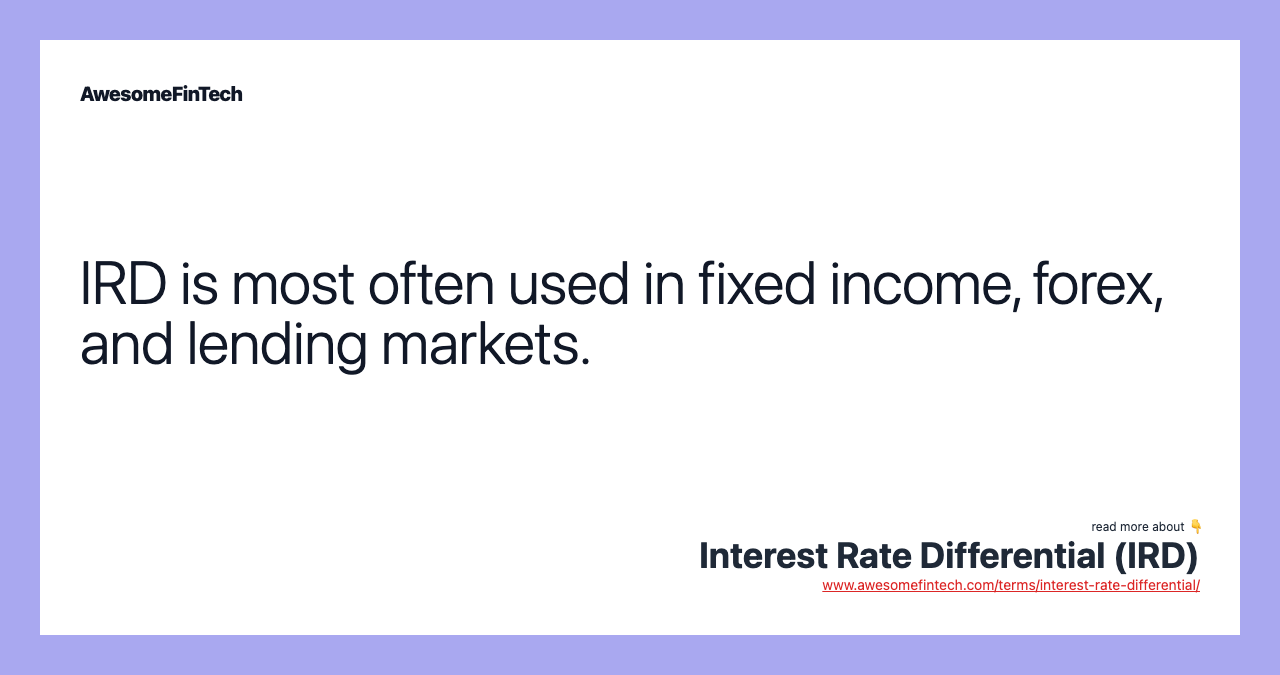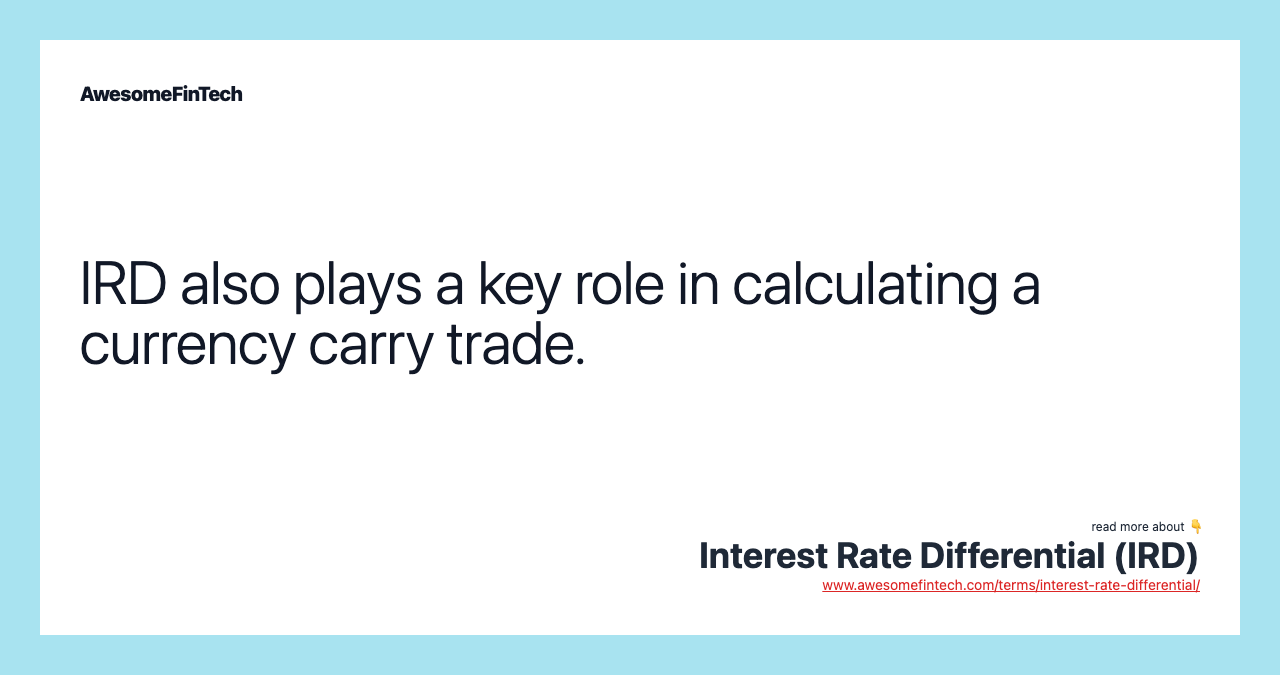Interest Rate Differential (IRD)
An interest rate differential (IRD) weighs the contrast in interest rates between two similar interest-bearing assets. Based on the interest rate parity, a trader can create an expectation of the future exchange rate between two currencies and set the premium, or discount, on the current market exchange rate futures contracts. An interest rate differential (IRD) weighs the contrast in interest rates between two similar interest-bearing assets. The IRD is also a key component of the carry trade, a trading strategy that involves borrowing at a low-interest rate and investing the proceeds in an asset that provides a higher rate of return. The IRD is used in the housing market to describe the difference between the interest rate and a bank's posted rate on the prepayment date for mortgages.

What Is an Interest Rate Differential (IRD)?
An interest rate differential (IRD) weighs the contrast in interest rates between two similar interest-bearing assets. Most often it is the difference between two interest rates.
Traders in the foreign exchange market use IRDs when pricing forward exchange rates. Based on the interest rate parity, a trader can create an expectation of the future exchange rate between two currencies and set the premium, or discount, on the current market exchange rate futures contracts.



Understanding Interest Rate Differential (IRD)
IRDs simply measure the difference in interest rates between two securities. If one bond yields 5% and another 3%, the IRD would be 2 percentage points — or 200 basis points (bps). IRD calculations are most often used in fixed income trading, forex trading, and lending calculations.
The IRD is used in the housing market to describe the difference between the interest rate and a bank's posted rate on the prepayment date for mortgages.
The IRD is also a key component of the carry trade, a trading strategy that involves borrowing at a low-interest rate and investing the proceeds in an asset that provides a higher rate of return. Carry trades often consist of borrowing in a low-interest rate currency, and then converting the borrowed amount into another currency with a higher yield.
Interest Rate Differential: A Bond Trade Example
The IRD is the amount the investor can expect to profit using a carry trade. Say an investor borrows $1,000 and converts the funds into British pounds, allowing for the purchase of a British bond. If the purchased bond yields 7% while the equivalent U.S. bond yields 3%, then the IRD equals 4%, or 7% - 3%. This profit is ensured only if the exchange rate between dollars and pounds remains constant.
One of the primary risks involved with this strategy is the uncertainty of currency fluctuations. In this example, if the British pound were to fall in relation to the U.S. dollar, the trader may experience losses.
Additionally, traders may use leverage, such as a factor of 10-to-1, to improve their profit potential. If the investor leveraged the borrowing by a factor of 10-to-1, they could make a profit of 40%. However, leverage could also cause larger losses if there are strong movements in exchange rates.
Interest Rate Differential: A Mortgage Example
When homebuyers borrow money to purchase houses, there may be an IRD.
For example, say a homebuyer purchased a home and took out a mortgage at a rate of 5.50% for 30 years. Assume 25 years have passed and the borrower only has five years left in the mortgage term. The lender could use the current market interest rate it is offering for a five-year mortgage to determine the IRD. If the current market interest rate on a five-year mortgage is 3.85%, the IRD is 1.65% or 0.1375% per month.
Interest Rate Differential (IRD) vs. Net Interest Rate Differential (NIRD)
The net interest rate differential (NIRD) is a specific type of IRD used in forex markets. In international currency markets, the NIRD is the difference between the interest rates of two distinct economic regions.
For instance, if a trader is long the NZD/USD pair, they would own the New Zealand currency and borrow the US currency. These New Zealand dollars can be placed into a New Zealand bank while simultaneously taking out a loan for the same amount from the U.S. bank. The NIRD is the difference in any interest earned and any interest paid while holding the currency pair position.
Related terms:
Asset
An asset is a resource with economic value that an individual or corporation owns or controls with the expectation that it will provide a future benefit. read more
Basis Points (BPS)
Basis points (BPS) refers to a common unit of measure for interest rates and other percentages in finance. read more
Bond Yield : Formula & Calculation
Bond yield is the amount of return an investor will realize on a bond, calculated by dividing its face value by the amount of interest it pays. read more
Currency Carry Trade
A currency carry trade is a strategy that involves using a high-yielding currency to fund a transaction with a low-yielding currency. read more
Currency Pair
A currency pair is the quotation of one currency against another. read more
Exchange Rate
An exchange rate is the value of a nation’s currency in terms of the currency of another nation or economic zone. read more
Fixed Income & Examples
Fixed income refers to assets and securities that bear fixed cash flows for investors, such as fixed rate interest or dividends. read more
Forex (FX) , Uses, & Examples
Forex (FX) is the market for trading international currencies. The name is a portmanteau of the words foreign and exchange. read more
Funding Currency
A funding currency is exchanged in a currency carry trade. read more
Futures Contract
A futures contract is a standardized agreement to buy or sell the underlying commodity or other asset at a specific price at a future date. read more